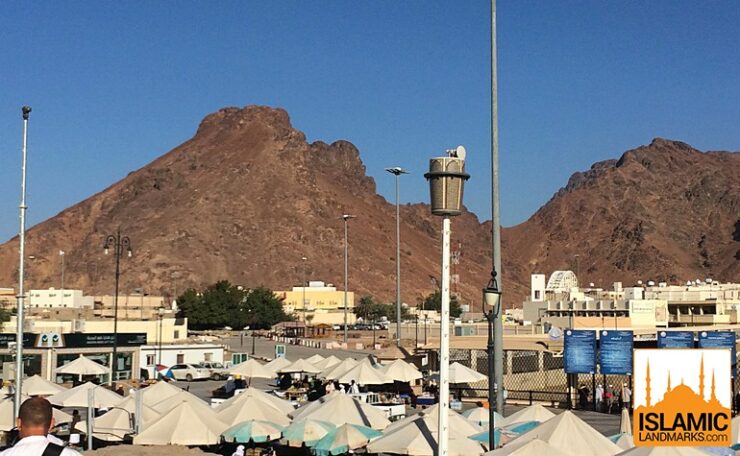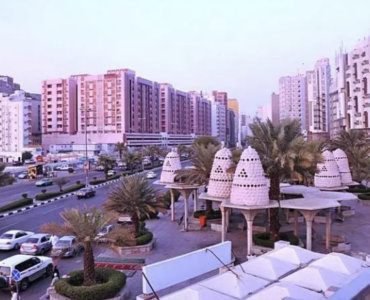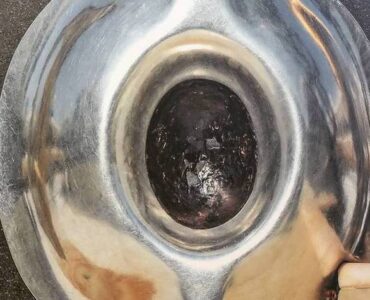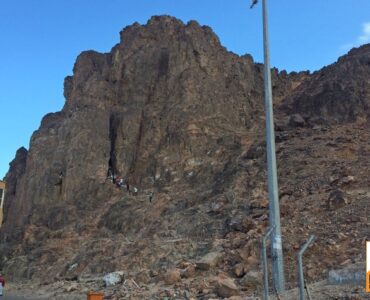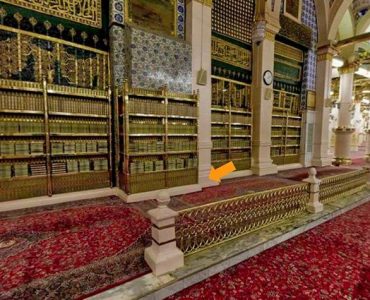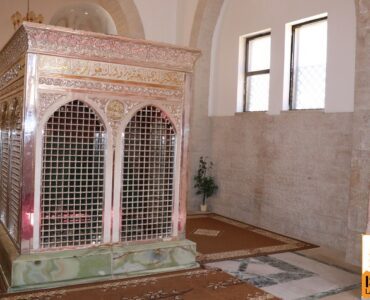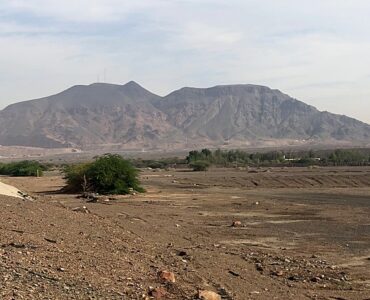This location, in northern Madinah, is where the Battle of Uhud took place in 3 AH (624 CE). It was the second war between the Muslims and the pagan Makkan forces following the Battle of Badr. An initial victory turned to defeat for the Muslims after some fighters left their position, mistakenly thinking the battle was over.
- After the humiliating defeat in the Battle of Badr a year earlier, the Quraysh of Makkah made preparations to muster a great army to fight the Muslims again and take revenge. They assembled an army of 3000 soldiers with 300 camels, 200 horses and 700 coats of mail. Wives and daughters of slained chiefs in Badr accompanied the army to see with their own eyes the spectacle of the killers being killed. Abu Sufyan was the commander-in-chief of the Makkan army and his wife Hind commanded the women’s section. Both were non-Muslims at the time and bitter enemies of Islam. The left and right flanks were commanded by Ikrimah ibn Abi Jahl and Khalid bin Waleed respectively. Amr ibn al-As was named the commander of cavalry and his task was to co-ordinate attack between the cavalry wings. (All three subsequently became Muslims and become great generals of Islam).
- The Prophet (ﷺ) left Madinah for the valley of Mount Uhud with a Muslim army of only 700 and drew up his troops for battle. Zubair bin al-Awwam (رضي الله عنه) was the commander of the right wing and Mundhir bin Amr (رضي الله عنه) was given the left wing of the army. Hamza (رضي الله عنه), the uncle of the Prophet (ﷺ) was made the advance guard. Mus’ab bin Umair (رضي الله عنه) was chosen as the standard-bearer of Islam and Abu Dujanah (رضي الله عنه) was fortunate enough to receive the Prophet’s sword (which was known as Zulfikar).
- Before the battle, the Prophet (ﷺ) had positioned 50 archers under Abdullah bin Jubair (رضي الله عنه) at Jabal al-Rumah. He (ﷺ) ordered them strictly to stay there until further orders, whatever may be the condition. They were to obstruct the enemy if they attacked the Muslims from the rear.
- The two armies set upon each other and a fierce battle ensued. The Muslim soldiers concentrated their attack on the eleven standard bearers of the pagans until they were all wiped out. As the enemy standards sank to the ground, the Muslim soldiers hurled themselves against the enemy. Abu Dujanah (رضي الله عنه) and Hamza (رضي الله عنه), fought with great fearlessness, and their heroic feats on the battlefield were to become legendary in Muslim military history.
- Tragically, Hamza (رضي الله عنه), the ‘Lion of Allah’, was martyred in the same battle he had dominated. He was killed by the javelin of Wahshi bin Harb, an Abyssinian slave, who with that successful throw earned his freedom from his master, Jubayr bin Mutim.
- Despite the loss of Hamza (رضي الله عنه), the Muslims managed to overcome the unbelievers who, faced with yet another defeat, began to flee. The pagan women also scattered as some of the Muslim soldiers gave chase.
- It was at this point of perceived victory that events began unravelling. The archers who had been entrusted with the safety of their brothers in faith disobeyed the Prophet’s clear orders and deserted their stations, thinking that the battle was over. Forty of the rearguards descended the mountain and left the Muslims vulnerable to a counter attack by the enemy.
- Khalid bin Waleed saw the sudden vacuum created by the disappearance of the rearguard and his cavalrymen attacked the Muslims from behind, killing many in the process. When the Muslims saw themselves surrounded, they were overtaken by panic and disorder and failed to map out a cohesive plan.
- The enemy fought their way close to the Prophet (ﷺ) who was hit with a rock and fell on his side. One of his front teeth was chipped, his lower lip was cut, and his helmet was damaged. As an enemy soldier thrust his sword at the Prophet (ﷺ), he caught his bone below the eye, and two rings from the Prophet’s helmet pierced his face. The blood ran down his face and he wiped it away, saying, “How can a people prosper who have stained their Prophet’s face with blood while he summoned them to their Lord!”
- Mus’ab bin Umair (رضي الله عنه), was targeted by the enemy as he was the Muslims standard-bearer and he was killed. Since Mus’ab (رضي الله عنه) resembled the Prophet (ﷺ) to a great extent, his killer, Abdullah bin Qam’a, thought he had slain the Prophet (ﷺ) and jubilantly shouted out that he had killed Muhammad.
- Rumours of the death of the Prophet (ﷺ) filtered through the Muslims, plummeting their morale. Grief stricken and lost, some of them simply abandoned the field, while others were infused with resolve and rallied saying, “Come, let us die for what the Prophet (ﷺ) gave his life.”
- The crisis receded only when Ka’b bin Malik (رضي الله عنه) caught a glimpse of the Prophet (ﷺ), making his way to join the besieged Muslims. K’ab recognised the Prophet’s eyes although his face was covered with the helmet. He cried loudly, “O Muslims, rejoice! Here is the Prophet!”.
- Ka’b’s words galvanised the remaining Muslims, and they streamed to the Prophet’s side. Within a short time thirty Companions assembled around him. The Prophet (ﷺ) decided against further combat, wisely choosing to retreat. He made his way through the rows and successfully led his troops towards the mountain pass.
- By retreating, the Prophet (ﷺ) managed to save his army from further losses; losses that had come about from simple disobedience of his orders. Disobedience had changed the Muslim victory in the Battle of Uhud into catastrophe, but with Allah’s help the Muslims were pulled back from the edge of disaster.
References: History of Madinah Munawwarah – Dr. Muhammad Ilyas Abdul Ghani, Fazail-e-Aamal – Sheikh Muhammad Zakariyya Kandhalvi, The life of Muhammad – Tahia Al-Ismail, When the Moon Split – Safiur Rahman Mubarakpuri

